WorldShare Acquisitions Release Notes, September 2021
Release Date: September 23, 2021
Introduction
This release of WorldShare Acquisitions provides 1 new feature in addition to numerous bug fixes. This feature will help you manage more complex workflows, including:
- Disable funds for new transactions
Many of these enhancements are the direct result of your feedback.
Recommended actions
For this release, we recommend that you review the following checklists and complete the relevant tasks so that you can adjust your policies and workflows and train your staff. These checklists identify updates that we have determined as significant for most institutions. We encourage you to review all of the items in the release notes to determine whether there are other items that might require additional action or follow up by your institution.
Administrative actions
These items require immediate action or decisions.
| Action |
|---|
|
None at this time. |
Follow-up actions
In an effort to keep your staff informed of new features and changes, you may also want to consider these items.
| Action |
|---|
|
Consider changing workflows to disable a fund for new transactions if it is not ready for use on orders and invoices. |
New features and enhancements
Disable a fund for new transactions
You can now disable a fund for new transactions. This saves you time and effort instructing staff not to use a specific fund that may have reached its limit or whose use is being temporarily suspended. Instead, you can disable it for new transactions, which will prevent them from using this fund for new items, while at the same time allowing them to finish using this fund for existing order items and invoice items. It will even allow you to invoice and pay for items using this fund, as long as the fund is already used on the corresponding order item. Previously, all funds in the current budget were enabled at all times, and you could not disable a fund for use by other users. Now, you can disable a fund for new transactions.
Note: In the future, we will also support disabling a fund for all uses. This will require that the fund is not in use on any open orders or invoices. If it is not, it can be disabled for all uses, and users will not be able to use the fund for any purpose, even closing out an existing item with this fund.
To disable a fund for new transactions:
- Go to Budgets.
- Open the current or next "bookable" budget.
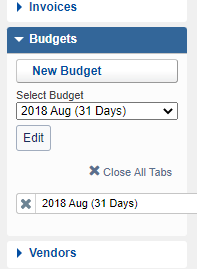
- Note a new Fund Status column displays with icons for the two statuses:
- Green checkmark icon = Enabled for use.
- Orange triangle with exclamation point = Disabled for new transactions.

- From the budget page, click the edit icon to the right of the Fund that you want to disable for new transactions.

- The Fund will be made editable.
- Use the dropdown in the Fund Status column to edit the Fund Status. By default, it is enabled. But, you can also disable new transactions.

- Click save to save the change to the new Fund Status.
- A dialog will then appear asking if you wish to apply this Fund Status to all the child funds of the selected fund as well? If you click yes, it will apply this status to all child funds. If you select no, it will only apply the change to the selected fund.

- Now, if you go to an order item or an invoice item and look up this fund for the order item or invoice item, the name of the fund will be in grey text and will not be selectable.

- This prevents you from selecting this fund for existing order items or invoice items.
- However, if you try to invoice an item using a fund that is disabled for new transactions, the item will be invoiced, and the fund selected for the invoice item will be the fund disabled for new transactions. (In this case, the invoice item is not considered a "new transaction" since it is simply a continuation of the order item.) In this way, you can pay for items using a disabled for new transactions fund using the same fund as selected on the order item.
- Note: If you change the fund selection of the invoice item, however, you will not be able to change it back to the disabled fund. You will have to delete and re-invoice the item to use the disabled fund for the invoice item.
- Furthermore, you can place orders with items where the disabled fund was selected previously, and you can pay invoices where the disabled fund was selected previously as well.
- Note: If you change the fund selection of the order item or invoice item, however, you will not be able to change it back to the disabled fund. You would have to re-enable the fund to select it in this case.
- On the other hand, if you try to import a MARC order file with this fund in the 949 $p field, the related items will be imported, but you will receive a warning for those items in the logs and e-mail notification that says that fund cannot be imported because it is disabled.
- E-mail notification:
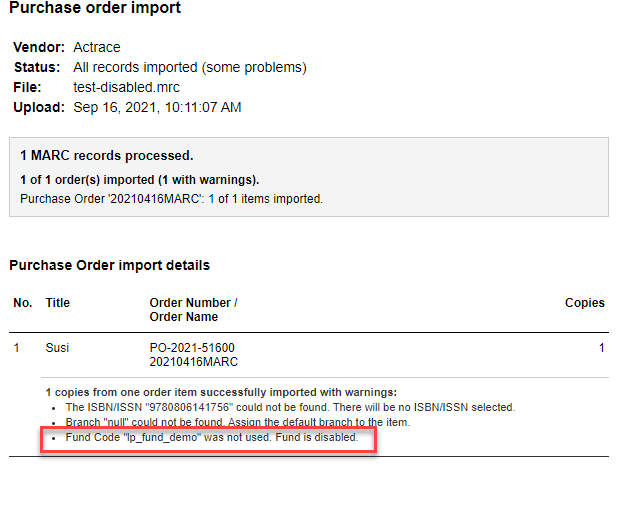
- Partner Exchange Services logs:
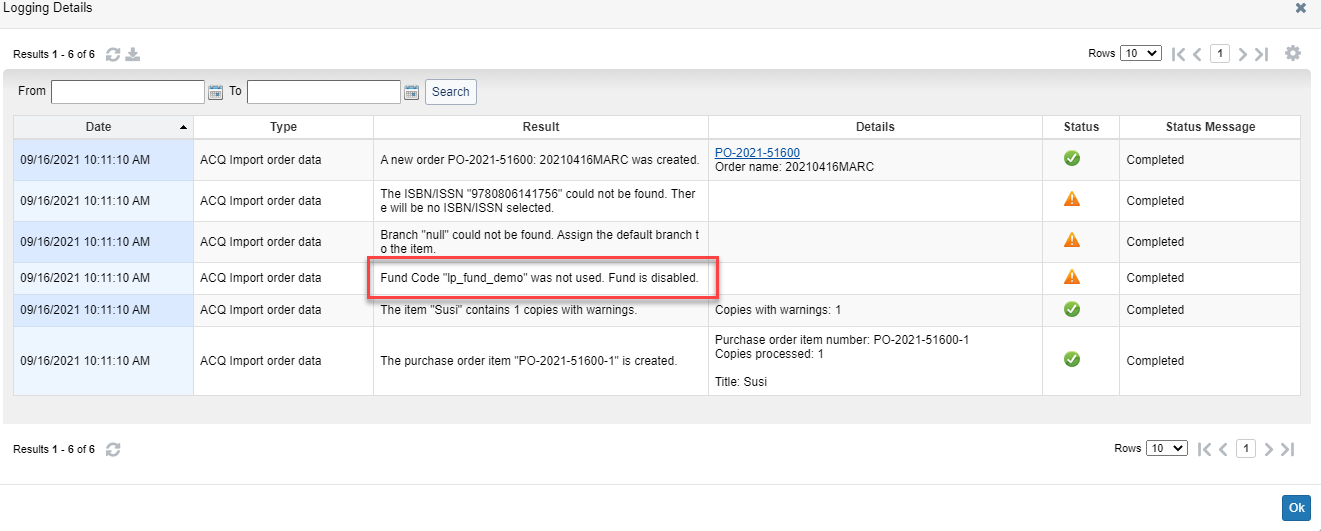
- E-mail notification:
- Similarly, you cannot create an order item template with a disabled fund. If you attempt to create an order item template from an order item where a disabled fund is selected, it will give you an error, and the order item template will not be saved.
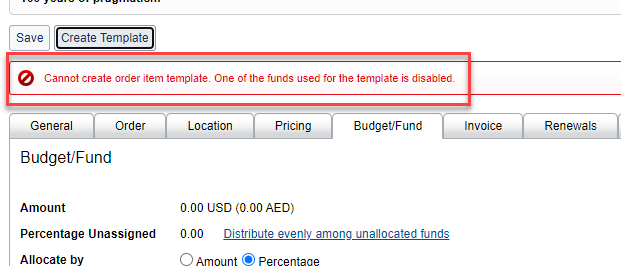
- Also, if you try to use an order item template that uses a disabled fund to add a new item to an order, you will receive an error when you click Add next to the order.
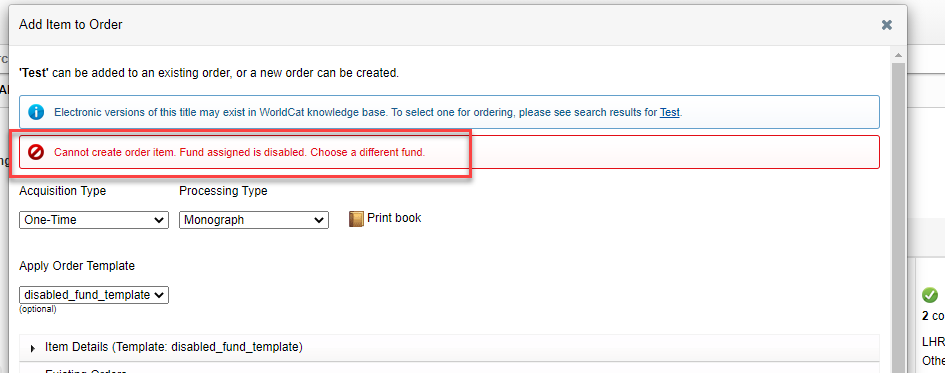
- If you attempt to renew a renewal list where a disabled fund is used as a target fund in the Fund Mapping table, the renewal list will not be renewed, the target fund will be removed, and an error will display that says, "Unable to renew the order items. One or more of the fund(s) used is disabled. These fund(s) have been removed from the fund mapping. Please select a new fund and renew again."

- If you have selected a disabled fund as a target fund in the close budget dialog, when you open the close budget dialog the next time, the fund will be automatically removed. You cannot use disabled funds as a target fund when closing a budget.
- When you copy the budget structure of a budget with disabled funds, it will ask you if you want to copy funds that are disabled for new transactions. If you check this option, funds that are disabled for new transactions will not be copied to the new budget.
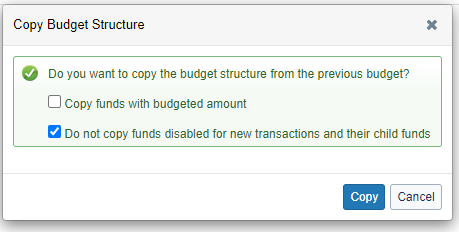
Bug fixes
Changing currency of invoice is now auto-saving
When you change the currency of an invoice, this new value is automatically saved. Previously, if you changed the currency of an invoice to something other than the institution currency, it would not auto-save, and the save button would not be enabled. If you closed the page without making another change to the invoice, it would not save the new currency. You had to make another change to the invoice in order to save the new currency. This no longer occurs, though. A change to the currency automatically results in a save to the invoice.
Selecting multiple funds for an invoice item no longer removes the item from the screen
When you change a fund for an invoice item and then select "Assign multiple budgets/funds," the items are no longer removed from the screen. Previously, if you changed the fund of an invoice item and then immediately clicked on the Assign multiple budgets/funds link, all the items would disappear from the invoice. Now, this does not occur, and the items stay on the invoice page.
Invoice item and invoice search working in Platform
When you retrieve an invoice item or an invoice item search using the platform, it now always returns the correct results. Previously, it was not returning results in the case certain invoices would be shown in the results. This problem has been fixed, and now, the invoice item read and search operations work as expected.
Deleting an order item template no longer asks you to delete a previously selected template
If you select more than one order item template in a session, and then you try to delete a template, it will ask if you want to delete that specific template. Previously, if you selected multiple templates in a session, when you went to delete a template, the confirmation screen would ask you if you wanted to delete the previously selected template, rather than the currently selected one. If you confirmed, it would delete the previously selected template. This made deleting templates very difficult in some cases. This bug has been fixed, and now, you can delete the currently selected template.
Ordered purchase requests are now showing in the requested items search
If you search for purchase requests with the Order Status of Ordered, all the ordered purchase requests now display. Previously, if you tried to view Ordered purchase requests under Purchase Requests > Request Items, you would not see any results for the ordered purchase requests. These ordered purchase requests now display as they should.
Known issues
No red text or red background when fund has no more money
If the fund balance goes to 0.00 or below, it is supposed to turn red (text and background) to indicate that the fund is out of money. This feature will be temporarily not present in the system. We hope to fix this issue in an out-of-cycle release.
Styling issues with new fund auto-complete
With this release, we have introduced a new fund auto-complete. This auto-complete works largely the same as the previous version, but this one is currently styled a bit differently. It appears larger than other auto-completes and dropdown menus and has more space around the selected text. This will be modified in the future to better fit the current style of the system, but for now, there will be a difference between this fund auto-complete and other auto-completes and dropdown menus on the page. Thank you for your patience with this issue.
Important links
Support website(s)
Support information for this product and related products can be found at:
